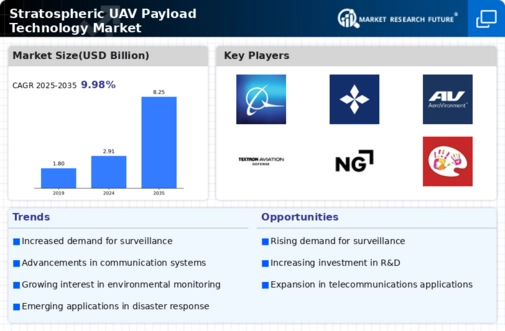Top Industry Leaders in the Stratospheric UAV Payload Technology Market

The competitive landscape of the stratospheric UAV (Unmanned Aerial Vehicle) payload technology market is instrumental in advancing the capabilities of high-altitude, long-endurance UAVs, playing a crucial role in various applications, including surveillance, communication, and atmospheric research. Key players in this market employ diverse strategies to navigate challenges and meet the increasing demand for innovative and reliable payload technologies for stratospheric UAVs.
Key Players:
Airbus SAS (Netherlands)
The Boeing Company (US)
Lockheed Martin Corporation (US)
QinetiQ Group PLC (UK)
Thales Group (France)
Arca Space Corp. (US)
Near Space Systems
Inc. (the US)
and OpenStratosphere SA (Switzerland).
Strategies Adopted:
The stratospheric UAV payload technology market deploy strategic initiatives to address the evolving needs of defense, scientific, and commercial users. Notable strategies include continuous investment in research and development, strategic collaborations, diversification of payload portfolios, and a focus on adaptability. Lockheed Martin Corporation emphasizes R&D investments to develop multi-functional payloads that can cater to a range of mission requirements, showcasing a commitment to versatility. Strategic collaborations between Raytheon Technologies Corporation and research institutions aim to optimize payload technologies for scientific research applications, demonstrating a collaborative approach to addressing the unique challenges of stratospheric UAV missions.
Market Share Analysis:
The stratospheric UAV payload technology market is influenced by factors such as the performance and adaptability of payload solutions, compliance with aviation regulations, pricing competitiveness, and the ability to provide tailored solutions for specific mission profiles. Companies excelling in delivering high-quality, technologically advanced payload technologies, ensuring compliance with stringent industry standards, and offering flexibility in meeting the diverse requirements of defense and scientific missions are well-positioned to capture a larger market share. Establishing strong relationships with UAV manufacturers, government agencies, and research institutions is crucial for maintaining a competitive edge in this dynamic sector.
News & Emerging Companies:
The stratospheric UAV payload technology market has seen the emergence of new companies aiming to address the growing demand for specialized and advanced payload solutions. Emerging entrants such as Silent Falcon UAS Technologies and Thales Group have gained attention for their focus on incorporating cutting-edge sensors and communication systems into stratospheric UAV payloads. These emerging companies contribute to the market by introducing fresh perspectives and agile approaches to address the evolving needs of defense, scientific, and commercial users.
Industry Trends:
The stratospheric UAV payload technology market underscores ongoing investment trends, with a strong emphasis on miniaturization, data processing capabilities, and enhanced communication technologies. Companies are investing significantly in the development of miniaturized payloads that do not compromise performance while minimizing the weight and power requirements of stratospheric UAVs. Additionally, there is a growing trend towards integrating advanced data processing algorithms into payloads to enhance real-time decision-making capabilities during missions. Enhanced communication technologies, such as secure and high-bandwidth data links, are also a focus to ensure seamless connectivity between stratospheric UAVs and ground control stations. These investments signify the industry's commitment to staying at the forefront of technological advancements and addressing the evolving requirements of stratospheric UAV missions.
Competitive Scenario:
The stratospheric UAV payload technology market is marked by intense competition among established players and the entry of innovative newcomers. With stratospheric UAVs becoming increasingly integral to defense, scientific, and commercial operations, companies aim to differentiate themselves by offering comprehensive payload solutions that address the challenges of high-altitude and long-endurance missions. Established players focus on refining their payload portfolios, expanding their market presence through strategic collaborations, and staying informed about emerging technologies and mission requirements. The entry of emerging companies adds dynamism to the market, fostering an environment of continuous improvement and responsiveness to the changing demands of stratospheric UAV users.
Recent Development
The stratospheric UAV payload technology market witnessed a significant development as Airbus SE announced the successful demonstration of its advanced scientific payload on a stratospheric UAV. The demonstration showcased the payload's capability to collect high-resolution atmospheric data for climate research and environmental monitoring. This development highlights Airbus SE's commitment to advancing scientific capabilities using stratospheric UAVs and reinforces its position as a key player in the market. The successful demonstration is anticipated to pave the way for broader adoption of stratospheric UAVs in scientific missions, showcasing the industry's recognition of the value of UAVs equipped with advanced payloads for atmospheric research and environmental monitoring.


